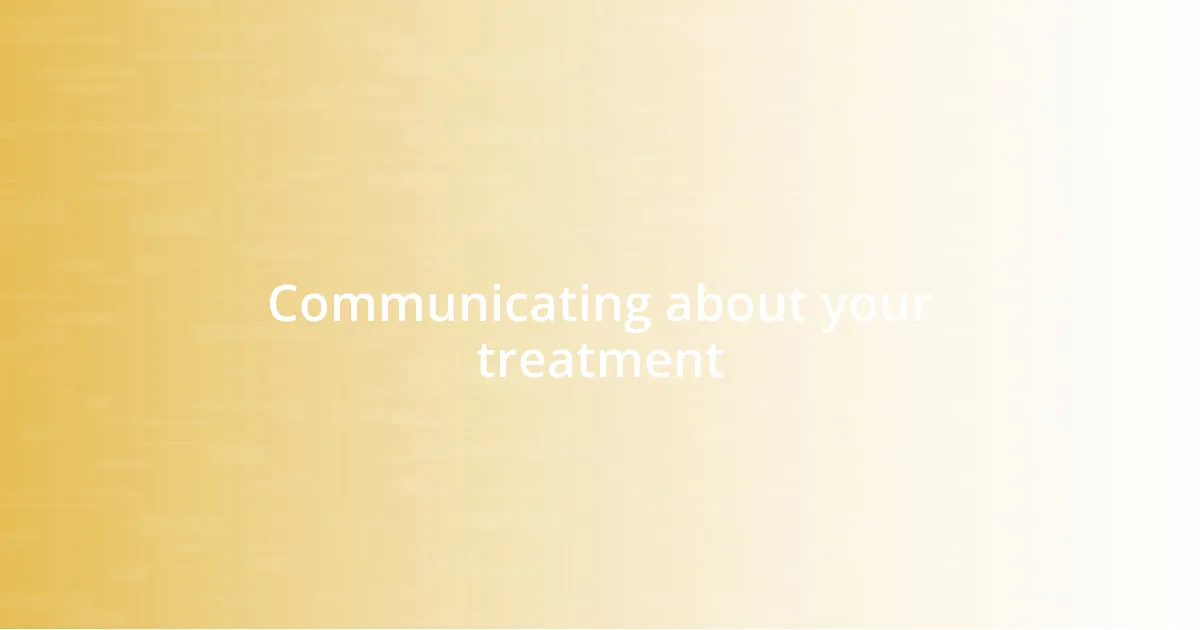Key takeaways:
- Stigma significantly impacts individuals undergoing treatment, often leading to feelings of isolation and betrayal from friends.
- Recognizing and articulating personal feelings can facilitate healing and create opportunities for open discussions about experiences.
- Seeking support from friends, online communities, and support groups fosters connection and shared understanding, helping combat stigma.
- Advocating for change through education, storytelling, and vulnerability can reshape perceptions and promote empathy in society.

Understanding stigma’s impact
Stigma can often feel like a heavy cloud hanging over individuals undergoing treatment. I remember attending a support group where the atmosphere was palpable with discomfort; people hesitated to share their experiences, afraid of judgment. Why is it that society often attaches labels instead of offering understanding?
The emotional toll of stigma is incredibly significant. During my treatment, I often felt isolated, as if I were navigating my journey in a bubble. It’s heartbreaking to think about how many people hesitate to seek help simply because they fear the stigma attached to their struggles. Haven’t we all experienced that feeling of standing on the outside, looking in?
Moreover, the impact of stigma extends beyond the individual, affecting relationships and community perceptions. I encountered friends who distanced themselves once they learned about my treatment, leaving me to grapple with feelings of betrayal and loneliness. Isn’t it disheartening to realize that empathy can sometimes be eclipsed by superficial judgments? The struggle against stigma isn’t just personal; it’s a societal challenge that we must confront together.

Recognizing personal feelings
Recognizing my personal feelings during treatment was a journey in itself. There were moments when I felt a wave of shame wash over me, especially when encountering the casual ignorance of others. I realized that these emotions weren’t just a reaction to stigma; they were an essential part of my healing process. Acknowledging my feelings allowed me to make sense of their complexity and understand my own resilience.
- I often felt anger when I heard dismissive comments from people, reminding me that they didn’t truly understand what I was experiencing.
- There were days when I felt utterly alone, which prompted me to reach out and connect with others who understood my journey.
- My feelings of vulnerability pushed me to confront the stigma head-on, transforming my distress into a source of strength that fueled my motivation to be an advocate for change.
Learning to recognize and articulate these feelings not only alleviated some of the pain, but also created a space for open discussions, which I found incredibly empowering.

Seeking support from others
Seeking support from others was crucial during my treatment journey. I found solace in connecting with friends who had similar experiences. It was refreshing to share fears and laugh together about the absurdity of some stigmatizing comments we encountered. I can still recall a heartfelt discussion with a close friend who not only listened but also shared her own story. That openness was therapeutic—it felt like shedding a heavy cloak.
At times, the most unexpected sources of support came from online communities. I joined a forum where individuals openly discussed their battles with stigma. Reading others’ stories made me realize I wasn’t alone; even though we were miles apart, our shared struggles formed a bond that transcended any distance. I remember one instance when a stranger’s encouraging words about resilience lifted my spirits—it’s amazing how a few kind words can spark hope in a challenging moment.
Support groups can act as safe havens, offering that much-needed sense of belonging. I attended a local meet-up and was astonished by the warmth in the room. Hearing others eloquently express what I often struggled to articulate made me feel seen and understood. Together, we formed a tapestry of shared experiences, weaving threads of empathy and strength that transformed our individual challenges into a collective journey of healing.
| Type of Support | Personal Experience |
|---|---|
| Friends | Connecting over shared experiences, leading to laughter and understanding |
| Online Communities | Finding unexpected support and encouragement that sparked hope |
| Support Groups | Creating a safe space where shared struggles transformed into collective strength |

Strategies for coping with stigma
One effective strategy for coping with stigma that I discovered was reframing negative thoughts. When someone made an ignorant comment, I practiced replacing my hurt with a question like, “What do they really know about my journey?” This simple shift helped me gain perspective and lessen the emotional impact of their words. I can still remember a moment when someone dismissed my experience outright. Instead of letting it ruin my day, I reminded myself that their ignorance didn’t define my reality.
Educating those around me also became another powerful tool in my coping kit. I started small, sharing my experiences with close family and friends, helping them understand that stigma isn’t just a word—it’s an emotional weight. I vividly recall explaining to a family member how their comments affected me. Their genuine surprise and willingness to listen were pivotal moments that empowered me to advocate for myself. Have you ever felt the relief that comes from simply being heard? For me, it transformed personal shame into an opportunity for growth and connection.
Lastly, embracing vulnerability proved to be a significant strategy for me. I learned that showing my true self—including my fears and insecurities—fostered deeper connections with others. One day, I shared my feelings of inadequacy at a support group, and the response was overwhelming. People opened up, sharing their own vulnerabilities, creating an atmosphere of mutual understanding. It made me realize that vulnerability is not a weakness; rather, it’s a bridge that connects us humanely. In a world that often feels isolating, don’t you think allowing yourself to be vulnerable can ignite healing and strength?

Communicating about your treatment
Communicating about my treatment felt daunting at first, but I soon realized it was essential for both my healing and for combating stigma. I vividly remember sitting across from my doctor, grappling with the emotions tied to my diagnosis. I often found myself asking, “How can I make them see what I’m really feeling?” This prompted me to articulate my thoughts more clearly, allowing my healthcare team to understand my experience beyond just medical terminology.
Opening up about my treatment didn’t stop with professionals; it extended to friends and family too. During a casual dinner with close friends, I chose to discuss the struggles I faced with my treatment. I started with, “You know, it’s hard for me to navigate conversations about my health.” To my surprise, this sparked a deeper dialogue, revealing that some of them had faced similar challenges. Moments like these reminded me of the magic that happens when we share our stories—it’s as if the weight lightens, revealing paths toward mutual understanding and support.
I also discovered the importance of tailored communication. Not everyone knows how to handle conversations about health, so I began suggesting simple phrases or questions to my loved ones, fostering a more supportive environment. When I gently advised a friend to ask, “What can I do to support you right now?” it transformed our interactions. It made me realize that by guiding others on how to engage with me, I wasn’t just advocating for myself—I was creating a culture of empathy. Have you ever thought about how small changes in communication can reshape the dynamics of your relationships? It’s a powerful tool that deserves attention.

Building resilience through experiences
Building resilience through experiences is something I learned firsthand during treatment. There was a moment, right after a particularly tough session, when I felt completely defeated. I decided to take a walk to clear my mind, and as I strolled through the park, I couldn’t help but notice others engaging in their daily lives. It struck me then that everyone has their struggles, and my journey, while challenging, was part of a bigger narrative. This realization strengthened my resolve and reminded me that resilience often sprouts from connection and reflection.
Reflecting on my experiences has become a powerful catalyst for growth. I began journaling to unpack the emotions tied to my treatment and the stigma I faced. One evening, as I wrote about a painful encounter with a stranger who had assumed my condition was a weakness, I felt a mix of anger and sadness. However, as I continued writing, a shift occurred. I started writing about how that moment pushed me to educate others and stand up for myself. It was enlightening to see how negative experiences could be reframed into opportunities for resilience and personal growth. Have you ever explored how your challenges can transform into strengths?
Ultimately, I learned that each experience, even the negative ones, serves as a building block for resilience. I can recall a time during group therapy when I shared my story about being marginalized because of my treatment. By the end of the session, not only did I feel lighter, but I also inspired others to share their stories. It was in that shared vulnerability that I realized resilience isn’t just about enduring hardships; it’s about learning from them, growing together, and emerging stronger. Isn’t it fascinating how openly sharing our experiences can reshape our understanding of resilience?

Advocating for change in perceptions
Advocating for change in perceptions has become a personal mission for me. I distinctly remember a moment at a support group where a fellow member shared the hurtful comments they received from strangers. Engaging in a discussion afterward, I felt compelled to challenge those misconceptions head-on. I spoke about how our experiences, though painful, could serve as powerful teaching moments. I asked, “What if we could turn these moments of stigma into opportunities for education?” This sparked a collective resolve in the room to combat stigma in our communities.
In my journey, I found that creating awareness goes beyond conversations—it’s about storytelling. I decided to share my narrative on social media, detailing the misconceptions surrounding my condition. Sharing that post, I felt butterflies in my stomach, unsure of how others would react. But when the comments began to flood in, expressing support and understanding, I realized the impact our voices can have. People shared my post, and suddenly, the conversation grew beyond my personal circle. Have you ever wondered how one story can ripple through a community, changing minds and fostering compassion?
Moreover, I learned that advocacy can be as simple as a kind gesture or a thoughtful question. Once, when a colleague inquired about my treatment with genuine curiosity, it opened the floodgates for an enlightening conversation. We discussed not only my journey but also the broader stigmas surrounding mental health. I couldn’t help but feel grateful—this small exchange allowed us both to confront our own biases. It made me realize that advocating for change is often about nurturing curiosity and kindness. Isn’t it incredible how a simple dialogue can ripple through our social fabric, prompting change one conversation at a time?













